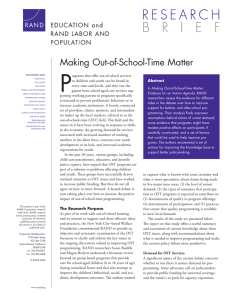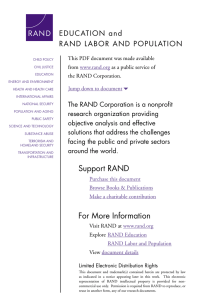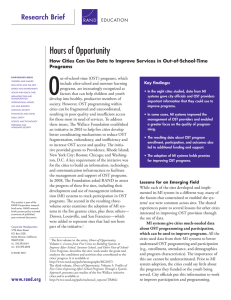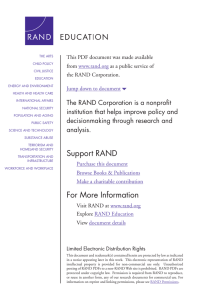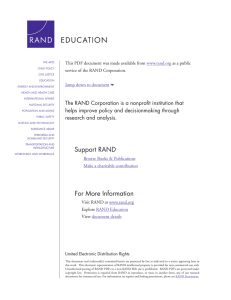HOT TOPIC March 2005 Making Out-of-School-Time Matter
advertisement
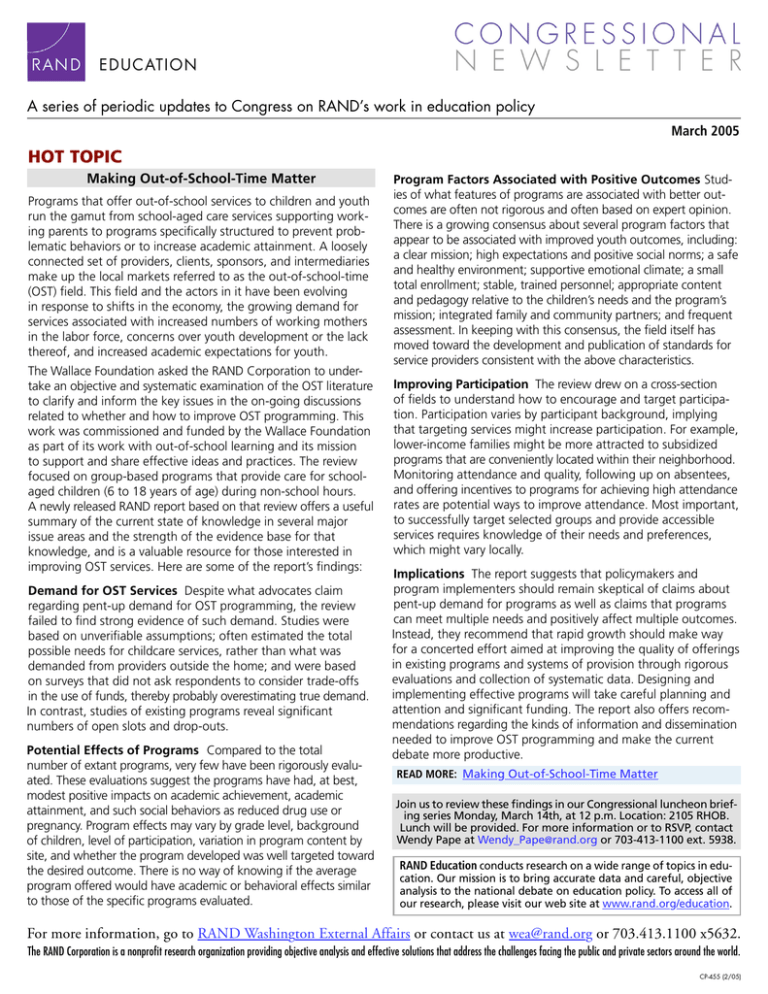
A series of periodic updates to Congress on RAND’s work in education policy March 2005 HOT TOPIC Making Out-of-School-Time Matter Programs that offer out-of-school services to children and youth run the gamut from school-aged care services supporting working parents to programs specifically structured to prevent problematic behaviors or to increase academic attainment. A loosely connected set of providers, clients, sponsors, and intermediaries make up the local markets referred to as the out-of-school-time (OST) field. This field and the actors in it have been evolving in response to shifts in the economy, the growing demand for services associated with increased numbers of working mothers in the labor force, concerns over youth development or the lack thereof, and increased academic expectations for youth. The Wallace Foundation asked the RAND Corporation to undertake an objective and systematic examination of the OST literature to clarify and inform the key issues in the on-going discussions related to whether and how to improve OST programming. This work was commissioned and funded by the Wallace Foundation as part of its work with out-of-school learning and its mission to support and share effective ideas and practices. The review focused on group-based programs that provide care for schoolaged children (6 to 18 years of age) during non-school hours. A newly released RAND report based on that review offers a useful summary of the current state of knowledge in several major issue areas and the strength of the evidence base for that knowledge, and is a valuable resource for those interested in improving OST services. Here are some of the report’s findings: Demand for OST Services Despite what advocates claim regarding pent-up demand for OST programming, the review failed to find strong evidence of such demand. Studies were based on unverifiable assumptions; often estimated the total possible needs for childcare services, rather than what was demanded from providers outside the home; and were based on surveys that did not ask respondents to consider trade-offs in the use of funds, thereby probably overestimating true demand. In contrast, studies of existing programs reveal significant numbers of open slots and drop-outs. Potential Effects of Programs Compared to the total number of extant programs, very few have been rigorously evaluated. These evaluations suggest the programs have had, at best, modest positive impacts on academic achievement, academic attainment, and such social behaviors as reduced drug use or pregnancy. Program effects may vary by grade level, background of children, level of participation, variation in program content by site, and whether the program developed was well targeted toward the desired outcome. There is no way of knowing if the average program offered would have academic or behavioral effects similar to those of the specific programs evaluated. Program Factors Associated with Positive Outcomes Studies of what features of programs are associated with better outcomes are often not rigorous and often based on expert opinion. There is a growing consensus about several program factors that appear to be associated with improved youth outcomes, including: a clear mission; high expectations and positive social norms; a safe and healthy environment; supportive emotional climate; a small total enrollment; stable, trained personnel; appropriate content and pedagogy relative to the children’s needs and the program’s mission; integrated family and community partners; and frequent assessment. In keeping with this consensus, the field itself has moved toward the development and publication of standards for service providers consistent with the above characteristics. Improving Participation The review drew on a cross-section of fields to understand how to encourage and target participation. Participation varies by participant background, implying that targeting services might increase participation. For example, lower-income families might be more attracted to subsidized programs that are conveniently located within their neighborhood. Monitoring attendance and quality, following up on absentees, and offering incentives to programs for achieving high attendance rates are potential ways to improve attendance. Most important, to successfully target selected groups and provide accessible services requires knowledge of their needs and preferences, which might vary locally. Implications The report suggests that policymakers and program implementers should remain skeptical of claims about pent-up demand for programs as well as claims that programs can meet multiple needs and positively affect multiple outcomes. Instead, they recommend that rapid growth should make way for a concerted effort aimed at improving the quality of offerings in existing programs and systems of provision through rigorous evaluations and collection of systematic data. Designing and implementing effective programs will take careful planning and attention and significant funding. The report also offers recommendations regarding the kinds of information and dissemination needed to improve OST programming and make the current debate more productive. READ MORE: Making Out-of-School-Time Matter Join us to review these findings in our Congressional luncheon briefing series Monday, March 14th, at 12 p.m. Location: 2105 RHOB. Lunch will be provided. For more information or to RSVP, contact Wendy Pape at Wendy_Pape@rand.org or 703-413-1100 ext. 5938. RAND Education conducts research on a wide range of topics in edu- cation. Our mission is to bring accurate data and careful, objective analysis to the national debate on education policy. To access all of our research, please visit our web site at www.rand.org/education. For more information, go to RAND Washington External Affairs or contact us at wea@rand.org or 703.413.1100 x5632. The RAND Corporation is a nonprofit research organization providing objective analysis and effective solutions that address the challenges facing the public and private sectors around the world. CP-455 (2/05)






